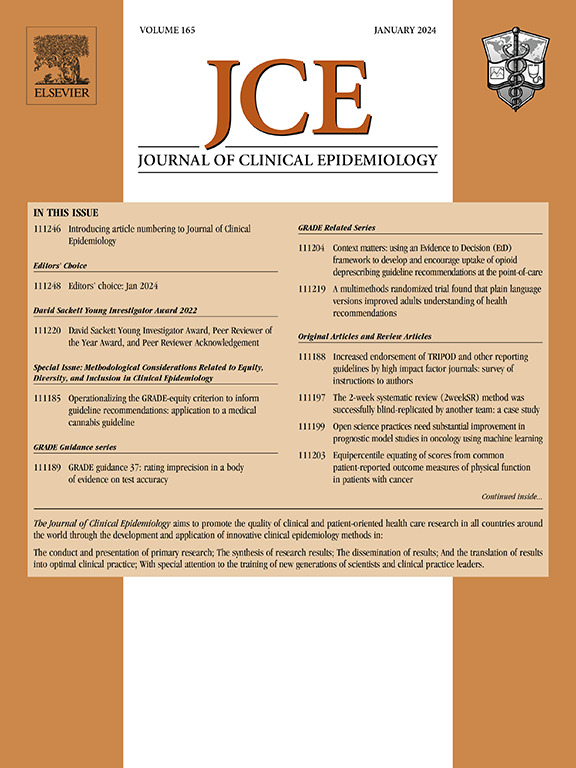有向无环图有助于了解五岁以下胎龄不足儿童营养不良的因果关系。
IF 7.3
2区 医学
Q1 HEALTH CARE SCIENCES & SERVICES
引用次数: 0
摘要
目的:小于胎龄(SGA)是导致营养不良(营养不足)的一个因果因素。关于这种因果关系的现有证据都是基于观察性研究,存在混淆和碰撞偏差。本研究旨在构建一个理论因果模型,以估计 SGA 对五岁以下儿童营养不良的影响:在因果模型中,我们将 SGA 状态作为暴露变量,将 6 个月至 5 岁儿童的营养不良(根据世界卫生组织标准诊断)作为结果变量。我们为三个利益相关者制定了因果关系估计值。文献综述采用了 "快速叙事综述 "方法。列出印度次大陆五岁以下儿童营养不良成因的研究(观察性和随机研究)均符合条件。对四个数据库(PubMed、Scopus、Web of Science 和 ProQuest)进行了检索,检索时间仅限于过去 10 年(检索日期:2023 年 12 月 15 日)。从文章摘要中提取了有关营养不良的因果因素(协变量)和研究特点的信息。然后,利用时间性、表面有效性、理论求助和反事实思想实验等顺序因果标准,通过连接暴露、结果和协变量节点,构建了有向无环图(DAG)形式的因果模型[DAGitty 软件]:结果:搜索共获得 4818 条记录,其中 342 篇摘要被收录。大部分研究在印度(39%)和孟加拉国(27%)进行。文献综述确定了 81 个因素,这些因素被分为 17 个节点,涉及五个领域:社会经济、父母、儿童相关、环境和政治。DAG 确定了 12 个不同的最小充分调整集(回归分析的条件集),以估算 SGA 对营养不良的总体影响:我们提供了一个以证据为基础的因果关系图,可最大限度地减少因在关注足月 SGA 婴儿营养不良的研究中因素选择不当而造成的偏差。DAG 和调整集将有助于未来研究的设计和数据分析。本文章由计算机程序翻译,如有差异,请以英文原文为准。

Directed acyclic graph helps to understand the causality of malnutrition in under-5 children born small for gestational age
Objectives
Small-for-gestational age (SGA) is a causal factor for malnutrition (undernutrition). The available evidence on this causal relationship is based on observational studies and suffers from confounding and collider biases. This study aimed to construct a theoretical causal model to estimate the effect of SGA on malnutrition in children aged less than 5 years.
Methods
For the causal model, we designated term-SGA status as the exposure variable and malnutrition at 6 months to 5 years of age (diagnosed by World Health Organization criteria) as the outcome variable. Causal estimands were formulated for three stakeholders. A “rapid narrative review” methodology was adopted for literature synthesis. Studies (observational and randomized) listing the causal factors of malnutrition in children aged less than 5 years from the Indian subcontinent were eligible. Four databases (PubMed, Scopus, Web of Science, and ProQuest) were searched and restricted to the last 10 years (search date: December 15, 2023). Information about the causal factors (covariates) of malnutrition and study characteristics was extracted from the article abstracts. Next, a causal model in the form of a directed acyclic graph (DAG) (DAGitty software) was constructed by connecting exposure, outcome, and covariate nodes using the sequential causal criteria of temporality, face validity, recourse to theory, and counterfactual thought experiments.
Results
The search yielded 4818 records, of which 342 abstracts were included. Most of the studies were conducted in India (39%) and Bangladesh (27%). The literature synthesis identified 81 factors that were grouped into 17 nodes, referring to 5 domains: socioeconomic, parental, child-related, environmental, and political. The DAG identified 12 different minimal sufficient adjustment sets (conditioning sets for regression analysis) to estimate the total effect of SGA on malnutrition.
Conclusion
We offer an evidence-based causal diagram that will minimize bias due to improper selection of factors in studies focusing on malnutrition in term-SGA infants. The DAG and adjustment sets will facilitate the design and data analysis of future studies.
求助全文
通过发布文献求助,成功后即可免费获取论文全文。
去求助
来源期刊

Journal of Clinical Epidemiology
医学-公共卫生、环境卫生与职业卫生
CiteScore
12.00
自引率
6.90%
发文量
320
审稿时长
44 days
期刊介绍:
The Journal of Clinical Epidemiology strives to enhance the quality of clinical and patient-oriented healthcare research by advancing and applying innovative methods in conducting, presenting, synthesizing, disseminating, and translating research results into optimal clinical practice. Special emphasis is placed on training new generations of scientists and clinical practice leaders.
 求助内容:
求助内容: 应助结果提醒方式:
应助结果提醒方式:


